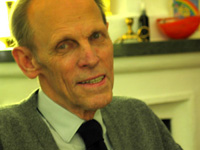
Bo Döös discusses the development of the first operational weather forecast model.
 |
Bo Döös discusses the development of the first operational weather forecast model. |
|
To listen to the streaming audio or video files, you will need RealPlayer or Real Alternative, both free downloads |
|||
|
How did the first operational weather forecasting experiment start? |
|||
|
Low bandwidth |
|||
|
High bandwidth |
|||
|
What was the next step? |
|||
|
Low bandwidth |
|||
|
High bandwidth |
|||
|
Why was Sweden able to take the lead in operational weather forecasting? |
|||
|
Low bandwidth |
|||
|
High bandwidth |
|||
|
Who else was involved in the Swedish experiment? |
|||
|
Low bandwidth |
|||
|
High bandwidth |
|||
|
What was it like working with Professor Rossby? |
|||
|
Low bandwidth |
|||
|
High bandwidth |
|||
|
Biography |
|
Bo R. Döös was professor of meteorology at the University of Stockholm until 1970. |
|
He then became Director of the Joint WMO/ICSU Planning Staff for the Global Atmospheric Research Programme (1971-1982), Director of the WMO/UNEP/ICSU World Climate Programme (1980-1982), and Manager of the UNEP/WMO/ICSU assessment of the impact of an increased atmospheric concentration of radiatively active gases (1982-1986). |
|
From 1986 to 1988, he was Visiting Scientist at the US National Climate Program Office, responsible for the development of a five-year US National Climate Program. From 1988 to 1991, he was Deputy Director of the International Institute for Applied Systems Analysis and leader of its Environment Programme. |
|
At present, he is chairman of Global Environmental Management. |
|
Contact information |
|
Prof. Bo R. Döös, Global Environmental Management, Packhusgränd 6, SE-111 30 Stockholm, Sweden. Email: bo.doos@telia.com. Web: www.misu.su.se/~doos/bo/. |